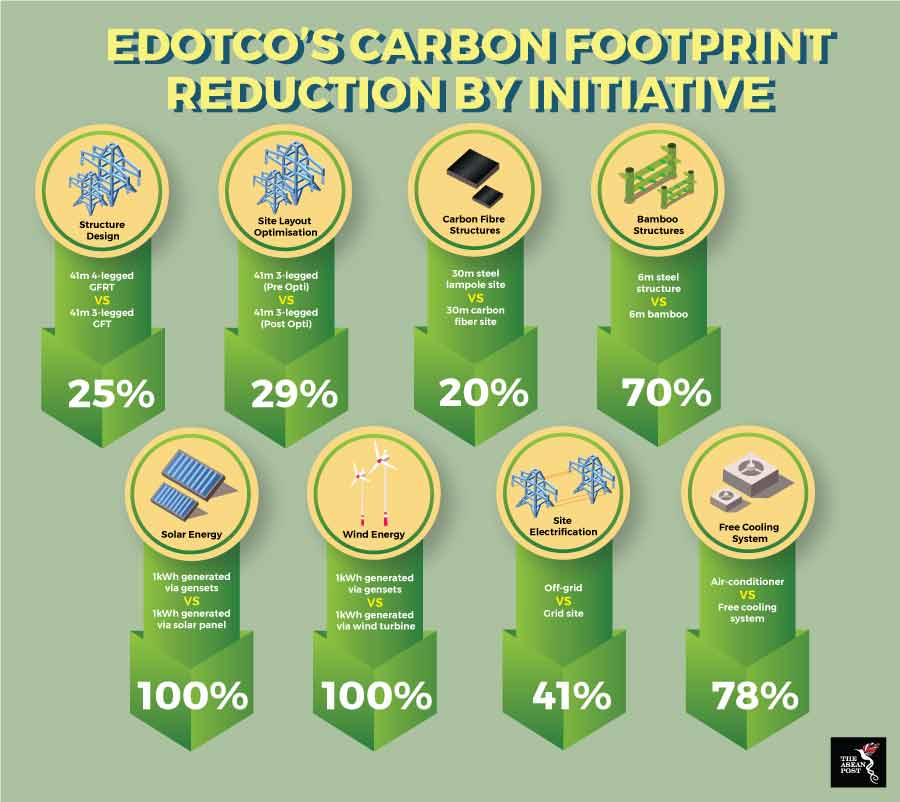Innovation, determination and a keen sense of foresight have been the cornerstones of edotco Group’s pioneering sustainability and green engineering drive.
The only regional tower company in Asia, edotco currently owns, manages and operates around 29,600 towers on the continent – making it the 13th largest tower company in the world.
Providing end-to-end solutions in the tower services sector from tower leasing, co-locations, build-to-suit, energy, transmission and operations and maintenance (O&M), edotco serves top mobile operators in the six markets they are currently in – Bangladesh, Cambodia, Malaysia, Myanmar, Pakistan and Sri Lanka – and have used their considerable clout to push for more sustainable manufacturing and design.
On 5 April, edotco was presented with Frost & Sullivan’s “Asia Pacific Telecoms Tower Company of the Year” award for 2019 – the third consecutive year the company won the category in the Asia Pacific level – largely thanks to their sustainable design innovations and renewable energy offerings.
The company started looking at renewable energy after being tasked with achieving a 40 percent reduction in carbon emission by 2018 when they first commenced operations in 2013 after being carved out as a subsidiary from Malaysian telecommunications group Axiata. It comfortably marked a 44 percent reduction in carbon emission last year while saving costs at the same time – proving that sustainability does not have to sacrifice profitability.

“We took the entire ecosystem of what we’ve built before and what we're building today and looked at ways to reduce carbon emissions and raw materials such as steel and concrete in all stages from manufacturing to on-site,” said Kumari Nalini, edotco Group’s Director of Engineering and Technology during an exclusive interview with The ASEAN Post.
“Was it rocket science? No, we just paid attention to details and thought outside the box,” explained Nalini, adding that edotco is targeting carbon neutrality for all their sites built in 2019.
Pioneering alternative solutions, optimising layouts
Thinking outside the box has led edotco to pioneer and champion the use of alternative materials for tower structures such as carbon fibre (August 2016) and bamboo (March 2017), both with the aim of reducing dependency on steel. They also recently pioneered the first hybrid solar-wind turbine energy solution in Myanmar to help provide off-grid reliability and to create an efficient way to power towers located in areas with low accessibility to electricity.
Carbon fibre structures weigh 70 percent less than conventional steel structures and offer a 20 percent reduction in carbon emission on site. Its high rigidity with a tensile strength of more than 10 times that of steel means carbon fibre towers are able to better withstand harsher forces of nature, especially high wind conditions. Carbon fibre is also highly resistant to corrosion, which contributes towards lower maintenance costs over the lifespan of the structure.
The idea for bamboo towers came during visits to Bangladesh in 2015 and 2016 when Nalini noticed that bamboo – which research has found has excellent rigidity and tensile strength – was being used in construction to support concrete. Working with the Bangladesh University of Engineering (BUET), a bamboo tower was created which could withstand wind gusts of up to 210 kilometres per hour (km/h) and had an expected lifespan of around 10 years. Bamboo towers only take 12 days to construct and mark a 70 percent reduction in carbon emission compared to steel.
Optimising layouts for site builds was another priority for Nalini, who reduced the size of site layouts by transitioning from 10x11 metre (m) sites to 7x7 m. The 60 percent reduction in area has also resulted in a 25-30 percent reduction in costs as the smaller layouts translate to carbon emission reduction and a more greener site due to the reduction in volume of material required.
"We don’t need to build so big. We just need to build what we need,” she noted.
TCO and early resistance
Not only are the hybrid solar-wind turbines in Myanmar an efficient, reliable and secure energy source, they also reduce costs and carbon emission through edotco’s Total Cost of Ownership (TCO) optimisation model; something Nalini pays extra attention to.
“We say that whatever we do, we should think for the next 10 years. Do I make my money in 10 years? Because if you want to go into renewable energy you can never be profitable in two or three years,” said Nalini.
She did admit, though, that it wasn’t easy to get everybody on board the sustainability train when she first started looking at renewable energy and alternative solutions.
“That was the first question my CEO asked me. What impact is it going to give us?”, said Nalini.
“I said I will do my part and create awareness. If more and more people buy into my idea, then more and more people will do it… It’s an uphill task.”
“But for me, we're the thought leaders and we need to create. And the fact we have a presence in six countries makes it a lot easier because we can, within that portfolio, start to infiltrate these thoughts all over.”
Related articles:
